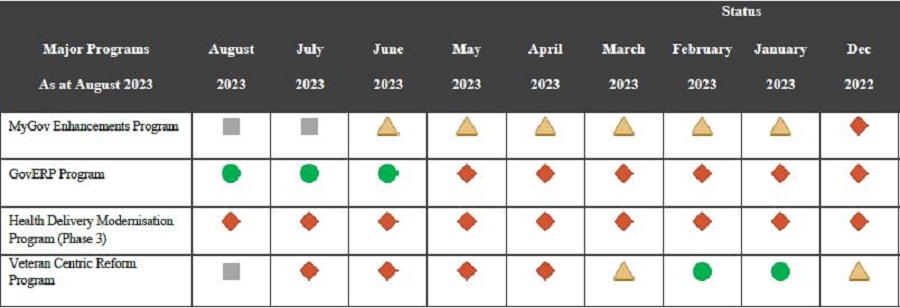Viewed
InnovationAus.com - Medicare payments system upgrade on the rocks
A long-running upgrade of the legacy payments systems underpinning Medicare has spent the last year on life support, with the latest phase of the critical overhaul stamped a project of concern for 12 consecutive months.
Internal reporting shows that phase three of the Health Delivery Modernisation program, which has been underway since mid-2022, began reporting a ‘red’ status in December 2022 and has not improved.
Only GovERP – the enterprise resource planning system consolidation project abandoned by the Albanese government in November last year – reported a red status for a similar number of months last year, according to the status report.
Shadow minister for government services and the digital economy Paul Fletcher said the project’s status, as well as Services Australia’s attempt to conceal it from public view in annual reporting, was deeply concerning.
“It remains unclear why this important ICT project has been allowed to perform so poorly against its internal KPIs,” Mr Fletcher said in a statement.
“We can’t afford to see another important digital government project collapse under Labor with no explanation as to what remediation work has been carried out.”

The Health Delivery Modernisation program began under the former Coalition government in 2016, replacing a previous attempt to outsource the health and aged care payments system that was ditched in the wake of the so-called ‘Mediscare’ campaign.
The outsourcing attempt was replaced by a project to upgrade the 200 separate applications and 90 different databases that underpin Medicare in 2018, but not before the government tried and failed to find an off-the-shelf digital payments platform.
The former government provided $134 million for the upgrade between 2019 and 2022, with the $37 million in funding used to perform essential maintenance. The remaining $97 million was committed to phase three of the program in the March 2022 Budget.
Funding was also to be used to make more health services available digitally, including Medicare enrolments, Medicare Provider Number applications for allied health professionals and Medicare complex care plan status’.
But less than six months after phase three began, the status was downgraded from ‘green’ to ‘red’ due to “overall budget underspend and slippage against key milestones”, Services Australia said in answers to questions on notice from Liberal Senator Maria Kovacic.
The program has also continued to report red in the months since, with a spokesperson from Services Australia confirming to InnovationAus.com that the status has remained unchanged since August 2023.
The traffic light system, which takes into account “key milestones, budget, financial benefits, business outcomes and risk” to the project, is used by the agency to determine “whether remedial activities are required”, according to the answers to questions on notice.

In a statement, the spokesperson said the “indicators do not necessarily mean a project will not be delivered on time or on budget, but alert stakeholders that some aspects of a program aren’t running to the original plan”.
Phase three has “already delivered functionality such online Medicare Entitlements Statements, Continence Aids Payments via myGov and online Medicare Enrolments”, with the agency on track to deliver a range of new and expanded digital services… in 2024,” the spokesperson added.
Despite the project reporting red, $42.3 million was spent on the program in the 2022-23 financial year, about 30 per cent less than the $58.8 million budgeted by Services Australia, leading the agency to revise its planned spending.
“Forecast expenditure for projects and programs are updated in line with agreed delivery plans, as a result forecast program expenditure was revised at key points during the 2022-23 financial year,” the agency said in answers to questions on notice.
A spokesperson said the underspend — which automatically triggers a red light on the internal report — was “due to the availability of skilled resources”, but would not indicate which aspects of the program had been delayed.
“Large and complex ICT projects have risks that need to be monitored and managed. This internal report is a way that the Agency can monitor the progress of the project in real time, responding to issues as they arise and demonstrating oversight early,” the spokesperson added.
The ‘health of projects document’ also shows GovERP reporting a red status for almost all of the 2022-23 financial year, before being reprofiled by Services Australia and reporting a green status between June 2023 and August 2023.
In November, just three months later, the government announced its new APS ERP approach, which will give agencies the option to choose their ERP provider from a panel of providers.
Red status reports for both projects correspond with Service Australia shedding more than 1200 staff following the end of several significant multi-year projects, namely the Welfare Payments Infrastructure Transformation.
Mr Fletcher said the Health Delivery Modernisation program was the latest example of the “digital drift” that has occurred since the arrival of the Albanese government last year.
“We’ve just experienced an unprecedented pandemic, so there should be a strong focus on supporting the underlying digital health infrastructure that Australians rely on,” he said in a statement.
Other projects to be binned by the government in recent months includes the Tax Office’s Modernising Business Registers program, as well as a digital credential sharing initiative between Services Australia and the New South Wales government.
Mr Fletcher also said that it was “deeply troubling” that Services Australia had hidden the program’s status in its latest corporate plan. In answers to QoN, Services Australia said that it made changes to its corporate plan and annual report to “better align information”.
Shadow minister for health and aged care Anne Ruston said that it was critical the government was supporting digital health systems with “tangible action that will actually make it easier and more affordable for Australian patients and health professionals”.
“At a time when we are seeing a primary healthcare crisis emerge under Labor and our hospital systems are facing serious pressures, the last thing the government should be doing is dropping the ball on supporting our digital health systems,” she said.
Updated on February 6 at 8:20am and at 6:35pm to include initial and updated statements from Services Australia
Author: Justin Hendry
This article appeared in InnovationAus.com on 5 February 2024
